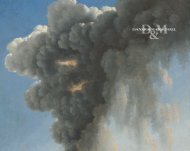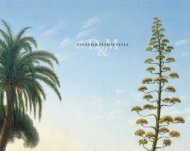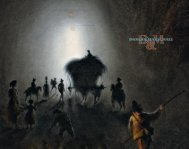Catalogue 2010 - daxer & marschall
Catalogue 2010 - daxer & marschall
Catalogue 2010 - daxer & marschall
You also want an ePaper? Increase the reach of your titles
YUMPU automatically turns print PDFs into web optimized ePapers that Google loves.
ARNOLD BöCKLIN<br />
A Spring Deep in a Narrow Gorge<br />
Arnold Böcklin<br />
(Basel 1827 - 1901 Fiesole)<br />
A Spring Deep in a Narrow Gorge, 1881<br />
Oil on canvas<br />
Signed with the initials and dated at<br />
the upper left AB/1881<br />
85 x 62 cm<br />
Provenance:<br />
Kunsthandlung Fritz Gurlitt, Berlin, 1881<br />
Friedrich C. Wilke (hat manufacturer), Guben,<br />
1898 Max Wilke, Guben,1914<br />
Erich Wolf-Wilke, Guben<br />
Elisabeth Wolf-Wilke, Gasstrasse, Guben (to 1945)<br />
Held at the Cracow Museum, 1946<br />
Acquired by Alexander Wax, Cracow,<br />
(emigrated to Israel in 1950, painting held there<br />
until 1976)<br />
Wolfgang Schuller Kunsthandel, Wertheim, 1976<br />
Private collection, Switzerland (since 1977)<br />
Literature:<br />
Rolf Andree, Arnold Böcklin. Die Gemälde, <strong>Catalogue</strong><br />
Raisonné, Schweiz. Institut für Kunstwissenschaft,<br />
Zürich (Oeuvrekataloge Schweizer Künstler 6),<br />
Basel and Munich 1977, no. 362<br />
Exhibited:<br />
A. Böcklin 1827-1901. Ausstellung zum 150. Geburtstag,<br />
Darmstadt, Mathildenhöhe, 1977, II, no.32,<br />
repr. p. 79.<br />
‘In uns selbst liegt Italien’ - Die Kunst der Deutsch-Römer,<br />
Munich, Haus der Kunst, 1987/1988, no. 4, p. 217.<br />
‘Deutsch-Römer’. Il mito dell’Italia negli artisti tedeschi<br />
1850-1900, Rome, Galleria Nazionale d’Arte<br />
Moderna e Contemporanea, 1988, no. 29, repr. in<br />
colour.<br />
Arnold Böcklin - Giorgio de Chirico - Max Ernst, Eine<br />
Reise ins Ungewisse, Kunsthaus Zürich, 1997/1998,<br />
no. 67, repr. in colour p. 166.<br />
Ibid, Munich, Haus der Kunst, 1998.<br />
Arnold Böcklin - Eine Retrospektive, Basel,<br />
Kunstmuseum, 2001; Paris, Musée d’Orsay, 2001;<br />
Munich, Neue Pinakothek, 2002, no. 65, repr. in<br />
colour p.275.<br />
54<br />
This important painting was executed in 1881 during Böcklin’s first sojourn in Florence.<br />
The Florentine years between 1874 and 1885 saw him at the height of his artistic powers. He produced<br />
many of his key compositions in this period – Die Hochzeitsreise (Honeymoon), Die Toteninsel (The<br />
Island of the Dead), Ruine am Meer (Ruin by the Sea), Odysseus und Kalypso (ulysses and Calypso), Der<br />
heilige Hain (The Sacred Grove) and Frühlingslandschaft (Spring Landscape).<br />
The title of the painting was not chosen by Böcklin but given to the work at a later<br />
date – many of his titles can be ascribed to his dealer, Fritz Gurlitt, who selected them with an eye to<br />
sales. Böcklin preferred a work to remain nameless, letting it speak for itself in its untitled state and<br />
drawing the viewer deep into his personal interpretation. 1<br />
His use of pure landscape as an instrument to focus on issues central to human existence<br />
is quite remarkable and recalls the symbolism of many of the landscapes of Caspar David Friedrich.<br />
This is unusual in Böcklin’s œuvre. His landscapes – with their ‘heightened images of universal<br />
nature’ 2 – very often do provide the central motif in his paintings but they then generally serve as a<br />
stage where ‘all the conflicts of the human condition’ as represented by ‘antiquity’s incomparable<br />
world of symbols’ 3 are played out.<br />
An interesting comparison can be made here with the first version of the famous painting<br />
Die Toteninsel. This was executed in 1880, a year earlier than the present painting. Initially, the first<br />
version of Die Toteninsel did not include figures. Böcklin only added them at a later stage, possibly at<br />
the request of his patron. 4<br />
Direct comparison of the two paintings is highly interesting and points up the<br />
extraordinary intensity and degree of subtlety with which Böcklin has handled the question of the<br />
enigma of human existence in the present landscape – the spring, the symbol of life, bound by the<br />
confines of a deep, narrow gorge, a metaphor for the determinate nature of human existence; the<br />
narrow patch of sky, representing the limitations of human knowledge; the unnatural gleam of the<br />
rays of light glimpsed through the slender trunks of the silver birches as an indication of the promise<br />
of redemption. 5 A tinge of darkened varnish applied to the bright patch of sky adds brilliance to the<br />
unnatural light effects.<br />
The painting, which is in excellent condition, displays striking painterly virtuosity<br />
throughout. The cliff walls framing the composition and the rocky ground at the foot of the gorge are<br />
executed in delicate, transparent brushstrokes. In the sky above, a narrow band of daylight turns the<br />
tops of the two trees nearest to the viewer to vivid green while the depths of the gorge are bathed<br />
in gloom. In the distance, vertical ribbons of light scatter reflections on the trunks of the birches.<br />
Silvery highlights gleam on the surface of the spring water as it flows over the boulders and accentuate<br />
the sparse vegetation at the base of the cliffs.<br />
A Spring Deep in a Narrow Gorge is one of the last remaining works from Böcklin’s most<br />
important period not held in a permanent collection.<br />
1. Arnold Böcklin - Eine Retrospektive, exhib. cat., Paris, Munich and Basel, 2001-2, p. 36.<br />
2. Zum Bild der allgemeinen Natur erhöhten Landschaften, exhib. cat., op. cit., p. 35.`<br />
3. Die unübertreffliche Symbolwelt der Antike, die alle Konflikte des Menschseins sichtbar macht: exhib. cat., op. cit., p. 36.4. S<br />
4. Exhib. cat., op. cit., p. 260, note 2.<br />
5. Rolf Andree, Arnold Böcklin. Die Gemälde, catalogue raisonné, Basel and Munich 1977, no. 362.






